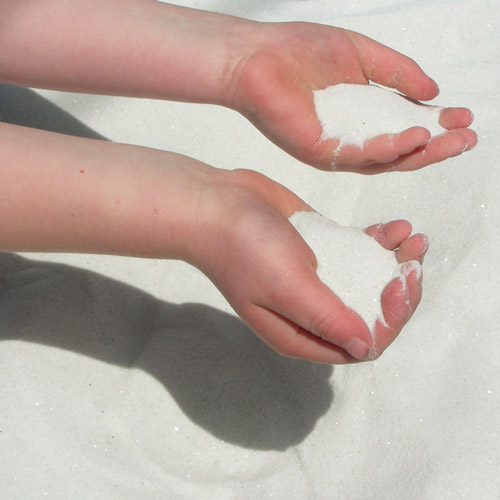Table of Contents
- What makes Safe Sand safe?
- Does Safe Sand work for sand castles?
- How do I figure out how much sand I need?
- Do you install the sand?
- How is the sand shipped?
- Does the sand work for aquariums and terrariums?
- What is silica exposure?
What makes Safe Sand safe?
Most commercial sand is manufactured by crushing quartz rocks into small grains of sand, with jagged corners that easily break, leading to hazardous dust. Quartz contains high amounts of crystalline silica, and its inhalation or ingestion is linked to health issues (see video about silica exposure below).
 On the other hand, our White Playsand is natural and safety-tested — our job is to make sure your sand does not contain inhalable crystalline silica, lead, asbestos, or any kind of contaminant or carcinogen.
On the other hand, our White Playsand is natural and safety-tested — our job is to make sure your sand does not contain inhalable crystalline silica, lead, asbestos, or any kind of contaminant or carcinogen.
- See our Material Safety Data Sheet (MSDS) for the detailed report.
- View test results for: Lead | Asbestos | Crystalline Silica Dust
Find out more about sand safety and silica dust in our Safe Sand Guide!
Does Safe Sand work for sand castles?
Our finely gradated and clean play sand is ideal for use in children’s sand boxes. It holds its shape when wet, and its texture is ideal for creating sandcastles and sand sculptures.
How do I figure out how much sand I need?
Do you install the sand?
Not at this time, unfortunately.
How is the sand shipped?
Small orders are shipped in 25lb boxes via USPS Priority mail. Typically these orders arrive within a week of ordering. If you order multiple boxes, the post office often separates them during transport and delivers them on different days.
Bulk orders are shipped in 2000lb tote sacks on pallets and are almost always shipped by carrier. Our shipping team will contact you to work out delivery logistics for your location.
Does the sand work for aquariums and terrariums?
Yes! Our sand is very popular for use in aquariums. It is safe for fish, creatures and plants. Please remove fish before adding sand and allow 24 hours for sand to fully settle before reintroducing fish.
What is silica exposure?
From WorkSafeBC: Silica is a common substance found in sand, rock, and building materials such as concrete and brick. Cutting, grinding, or drilling these materials releases dangerous crystalline silica dust into the air. This video shows how breathing in silica dust can cause permanent damage to the lungs.
